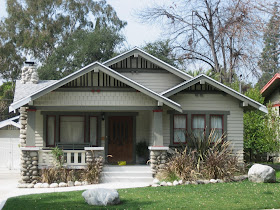



 Bungalow Heaven is bordered by E. Washington Blvd. to the North, E. Orange Grove Blvd. to the South, N. Lake Ave. to the West, and N. Hill Ave. to the East. Every spring, the Bungalow Heaven Neighborhood Association organizes a home tour with 8 different restored bungalows open to the public. For more Pasadena Arts and Crafts pictures, check out my post on the Gamble House.
Bungalow Heaven is bordered by E. Washington Blvd. to the North, E. Orange Grove Blvd. to the South, N. Lake Ave. to the West, and N. Hill Ave. to the East. Every spring, the Bungalow Heaven Neighborhood Association organizes a home tour with 8 different restored bungalows open to the public. For more Pasadena Arts and Crafts pictures, check out my post on the Gamble House.View Arts and Crafts in a larger map












